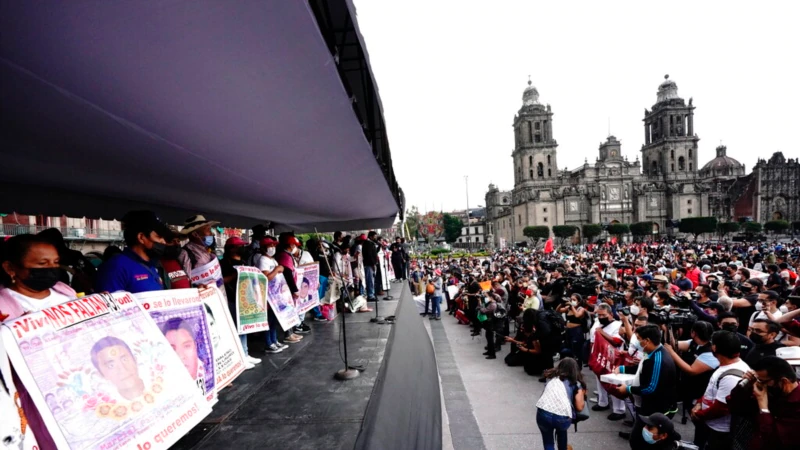Until the end of 2014, very few outside of Mexico had heard of Ayotzinapa. On the night of September 26, the small town in the state of Guerrero, home to the Escuela Normal Rural Raúl Isidro Burgos, would achieve sad notoriety linked to one of the most terrible scandals in the long history of violence in the Central American country.
Some 80 “normalista” students between the ages of 17 and 25 were attacked by the police and 43 would disappear as a result. Almost eight years later, the open case of the Ayotzinapa 43 continues to reveal a network of corruption that has reached the highest levels of power in Mexico, with chapters yet to be closed.
This August, the Investigation Commission for Truth and Justice created by the Government of President Andrés Manuel López Obrador declared the case a “state crime” and arrested high-ranking officials accused of obstructing justice.
In the voice of america we offer a condensed timeline of the most important events in the case so far.
The Night of Iguala
September 26, 2014
Some 80 Raúl Isidro Burgos Rural Normal School students were attacked by police from the municipality of Iguala. These normalista centers welcome very humble young people and are known for their social activism. In a sad coincidence, they were on their way to Mexico City to attend a protest commemorating the massacre of Tlatelolco students in 1968.
The clash was especially violent this time. Police shot up buses full of youths and, according to most official accounts, handed them over to the local “Guerreros Unidos” cartel, closely linked to law enforcement, the mayor of Iguala, and his wife. As a result, 6 people died and 43 students “disappeared”.
September 28, 2014
Tlachinollan, a non-governmental organization in the state of Guerrero, makes the first complaint of the use of state violence. At that time, 55 were reported missing. The NGO then became the families’ legal advisor.
September – October 2014
The authorities officially begin the search. Two days later, Amnesty International denounced the events and asked the Government of Mexico for a prompt resolution of the case.
The Government of Guerrero publishes a report where, for the first time, the participation of the Iguala police and “Guerreros Unidos” in the crime is recognized.
October 8, 2014
Some 15,000 people protest in Mexico City, in a first massive protest led by relatives of the victims which is then replicated in another 55 cities inside and outside the country.
That same day, the respected Argentine Forensic Anthropology Team makes its first visit to Guerrero at the request of the parents who do not trust the official experts. Argentine coroners identify 28 bodies discovered in a mass grave, but none belong to the disappeared.
The protests multiply in capitals like London, New York, Madrid, and Rio de Janeiro. Schools and universities in Mexico stage strikes to denounce the facts.
Shortly after, the United Nations gets involved and expresses concern about the continued disappearance of students. More than 60 mass graves are discovered as a result of the search.
November 2014
Murillo Karam announces that, according to the investigation, the Iguala police handed over the students to the “Guerreros Unidos” cartel. Murillo Karam ends the conference with “I’m tired” and unleashes the anger of Mexican society. That same day the families reject the official version.
Mexico City hosts another massive protest, this time with 100,000 demonstrators and aftershocks in 250 cities. More clashes and 11 arrests are reported.
December 8, 2014
The National Human Rights Commission of Mexico takes up the case and announces that laboratories in Innsbruck, Austria, identify the student Alexander Mora Venancio, among the remains found in the garbage dump of the neighboring town of Colula, where according to the official version the students were cremated. . Argentine coroners warn that protocols were violated and there is no way to guarantee the veracity of the findings.
The “historical truth” that never was
January 27, 2015
Attorney Murillo Karam declares that the “historical truth” has been determined and considers the case resolved. Strong pressure and discontent force him to resign a month later.
January – February- March 2015
The Inter-American Commission on Human Rights (IACHR) creates an independent investigation group that later becomes one of the main allies of the relatives.
Mexico is called to account to the UN Enforced Disappearance Session, where the parents of the students are invited. The relatives star in a series of caravans in the following months through cities in the United States, Europe and Latin America.
September 2015
The IACHR group of experts blames the Mexican government for the disappearance of the 43 students and discredits the official version that they were cremated. A second student, Jhosivani Guerrero De La Cruz, is identified by the Innsbruck laboratories.
111 members of the police and alleged members of “Guerreros Unidos” are arrested in connection with the crime. With the exception of the mayor of Iguala and his wife, no other state official has been arrested.
The United States withdraws 5 million of its aid to Mexico to combat drug trafficking in response to human rights violations in the country.
February – March – April 2016
The Argentine forensic experts and the group of experts of the IACHR officially reject the “historical truth” of the Mexican Government and publish a final report that reaffirms that the students could not have been incinerated in the Colula garbage dump, denouncing the coordination between the authorities to avoid the students escaping and government obstruction of the investigation.
September – November 2017
On the third anniversary of the events Some 100,000 demonstrators protest in Mexico City calling for the resolution of the case.
The recently approved Law on Forced Disappearances punishes officials involved with sentences of 40 to 60 years in prison and individuals from 25 to 50 years.
May 31, 2018
The Federal Court of Mexico issues a historic sentence in which it concludes that the Attorney General’s Office did not guarantee transparent processes and justice for the Ayotzinapa case. The Investigation Commission for Truth and Justice (CVAJ) is created.
state crime
June 2019
The video of the torture of one of the detainees in relation to the Ayotzinapa case is published on YouTube, proving that the Prosecutor’s Office used force in its proceedings.
The Attorney General of the mandate of the new president Andrés Manuel López Obrador, Alejandro Gertz Manero, creates the Special Investigation Unit to determine the causes of the disappearance, the obstruction of justice and other crimes committed during the investigations.
July 2020
The “historical truth” is officially canceled and the Attorney General requests the capture of 46 former officials, including the then head of the investigation, Tomás Zerón, accused of kidnapping, torturing and manipulating evidence in the case. Zerón is currently a fugitive in Israel.
According to the Prosecutor’s Office, there were elements that pointed to these people, but in the almost 6 years since the events, these files had not been processed.
August 18, 2022
The CVAJ presents its preliminary conclusions and establishes that the disappearance “involved criminal members of the Guerreros Unidos group and agents from various institutions of the Mexican State” and declares it a “state crime.”
“The creation of the ‘historical truth’ was an organized action by the apparatus of power, from the highest level of government, which concealed the truth of the facts, altered the crime scenes, concealed the links between the authorities and the criminal group and the participation of state agents, security forces and those responsible for law enforcement in the disappearance of the students,” the CVAJ report states.
The following day the former Prosecutor Jesús Murillo Karam and 83 other arrest warrants were issued against soldiers, police, administrative and judicial authorities and members of Guerreros Unidos.
Connect with the Voice of America! Subscribe to our channel Youtube and turn on notifications, or follow us on social media: Facebook, Twitter and Instagram.











Add Comment